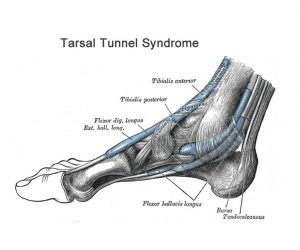Tarsal tunnel syndrome (TTS), is a compression neuropathy and painful foot condition in which the tibial nerve is compressed as it travels through the tarsal tunnel. This tunnel is found along the inner leg behind the medial malleolus (bump on the inside of the ankle). The posterior tibial artery, tibial nerve, and tendons of the tibialis posterior, flexor digitorum longus, and flexor hallucis longus muscles travel in a bundle through the tarsal tunnel. Inside the tunnel, the nerve splits into three segments. One nerve (calcaneal) continues to the heel, the other two (medial and lateral plantar nerves) continue on to the bottom of the foot. The tarsal tunnel is delineated by bone on the inside and the flexor retinaculum on the outside.
Patients with TTS typically complain of numbness in the foot radiating to the big toe and the first three toes, pain, burning, electrical sensations, and tingling over the base of the foot and the heel. Depending on the area of entrapment, other areas can be affected. If the entrapment is high, the entire foot can be affected as varying branches of the tibial nerve can become involved. Ankle pain is also present in patients who have high level entrapments. Inflammation or swelling can occur within this tunnel for a number of reasons.
The flexor retinaculum has a limited ability to stretch, so increased pressure will eventually cause compression on the nerve within the tunnel. As pressure increases on the nerves, the blood flow decreases. Nerves respond with altered sensations like tingling and numbness. Fluid collects in the foot when standing and walking and this makes the condition worse. As small muscles lose their nerve supply they can create a cramping feeling.


